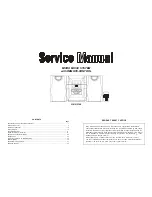
D8B Manual • Chapter 4 • page 111
Dither - To UV22 or Not to UV22:
That Is the Question
Digital audio’s weakness is its ability to accurately
reproduce extremely low-level signals. As the
amplitude decreases, there are fewer and fewer
bits available to accurately represent the audio wave.
In an analog system the audio simply sinks into
the noise floor. Even when covered by noise, the
waveform is still audibly intact. In a digital system,
low level audio simply becomes inaccurate and
sounds really bad. A few bits at the bottom of the
amplitude range aren’t capable of faithfully
converting the analog information to digital, let alone
reinterpreting the digital data into analog variations
in air pressure.
Dither is a low-level noise that combines with
your pristine audio at low levels to help keep enough
digital bits active to replicate an accurate waveform
throughout the conversion process from digital to
analog to digital—go figure that it takes noise to
make a system work that has no noise.
UV22 is a very good-sounding type of dither that
makes a way for more accurate reconstruction of
this low-level audio. The frequency of the UV22
dither noise is lower than the conventional process
and therefore provides a more transparent
reconstruction.
As a practical application, if your music is to be
mastered by someone else in a professional
mastering facility, you might not need to use the
UV22 process—too much dither can accumulate too
much noise. If you’re seeing the project through to
the end you have three primary options:
•
Don’t dither.
If your music is always loud—loud,
loud, loud—you might not need to worry about
dither because dither really only helps audio
quality at low levels. However, if there is a fade
out in your song, then of course everything isn’t
always loud and you’ll want to take advantage of
the UV22 process to feather the fade out with
excellent audio clarity.
•
Dither once.
The conventional approach has been
to avoid dithering until the final version is
mastered (prepared for duplication). In this case,
wait until the final mix is printed to the replication
master, then use a Normal UV22 setting on the
Stereo I/O in the Setup window. Dither only once
on Normal setting; dither noise is cumulative so
too much dither equates to senseless noise.
If your music contains only a few low-level
passages try using the “Low” setting on the
Stereo I/O. “Low” equates to a lower level of noise
and, though it might not provide as much
smoothing of low-level audio, it might be quite
sufficient—and less noise just seems like a better
choice wherever appropriate.
•
Dither twice.
If your music contains a wide
dynamic range, you might not be able to resist the
urge to use dither as you record to the multitrack.
In this case, plan to use the UV22 process twice:
use it once on the multitrack tracks—on the
“Low” setting; use it again on the final printing of
the master take—on the “Low” setting. If you use
the UV22 process twice, using it on Low setting
both times will closely equate to the dither noise
resulting from using it once in “Normal” position.
Summary of Contents for D8B 3.0
Page 8: ...D8B Manual Preface page 2 ...
Page 9: ...D8B Manual Chapter 1 page 3 Chapter 1 Getting Ready ...
Page 27: ...D8B Manual Chapter 2 page 21 Chapter 2 Where Is It ...
Page 47: ...D8B Manual Chapter 3 page 41 Chapter 3 What s On TV ...
Page 93: ...D8B Manual Chapter 4 page 87 Chapter 4 Applications ...
















































